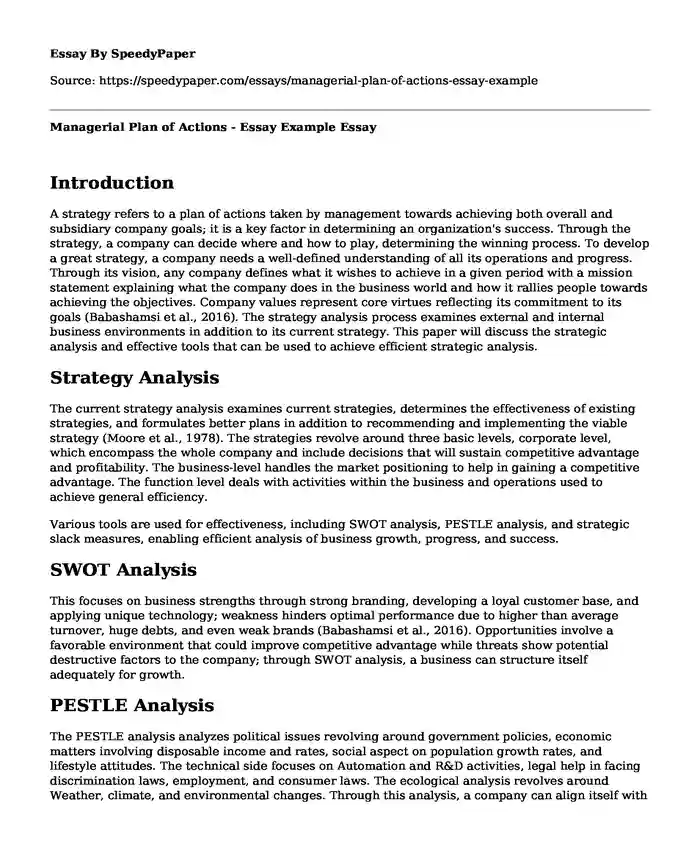
| Type of paper: | Essay |
| Categories: | Strategic management SWOT analysis |
| Pages: | 3 |
| Wordcount: | 612 words |
Introduction
A strategy refers to a plan of actions taken by management towards achieving both overall and subsidiary company goals; it is a key factor in determining an organization's success. Through the strategy, a company can decide where and how to play, determining the winning process. To develop a great strategy, a company needs a well-defined understanding of all its operations and progress. Through its vision, any company defines what it wishes to achieve in a given period with a mission statement explaining what the company does in the business world and how it rallies people towards achieving the objectives. Company values represent core virtues reflecting its commitment to its goals (Babashamsi et al., 2016). The strategy analysis process examines external and internal business environments in addition to its current strategy. This paper will discuss the strategic analysis and effective tools that can be used to achieve efficient strategic analysis.
Strategy Analysis
The current strategy analysis examines current strategies, determines the effectiveness of existing strategies, and formulates better plans in addition to recommending and implementing the viable strategy (Moore et al., 1978). The strategies revolve around three basic levels, corporate level, which encompass the whole company and include decisions that will sustain competitive advantage and profitability. The business-level handles the market positioning to help in gaining a competitive advantage. The function level deals with activities within the business and operations used to achieve general efficiency.
Various tools are used for effectiveness, including SWOT analysis, PESTLE analysis, and strategic slack measures, enabling efficient analysis of business growth, progress, and success.
SWOT Analysis
This focuses on business strengths through strong branding, developing a loyal customer base, and applying unique technology; weakness hinders optimal performance due to higher than average turnover, huge debts, and even weak brands (Babashamsi et al., 2016). Opportunities involve a favorable environment that could improve competitive advantage while threats show potential destructive factors to the company; through SWOT analysis, a business can structure itself adequately for growth.
PESTLE Analysis
The PESTLE analysis analyzes political issues revolving around government policies, economic matters involving disposable income and rates, social aspect on population growth rates, and lifestyle attitudes. The technical side focuses on Automation and R&D activities, legal help in facing discrimination laws, employment, and consumer laws. The ecological analysis revolves around Weather, climate, and environmental changes. Through this analysis, a company can align itself with various environments for profitability.
Cash Flow Analysis
Its ratio is given by Net Income + Interest Expense + Depreciation – Capital Expenditures–Dividends, showing cash flows generated, net of investments in the future, and payments to shareholders in addition to the resources a company can utilize for investing in other activities while still competing in its current markets.
The tools discussed above are very basic in the analysis since they revolve around key business success factors that greatly affect the business performance (Moore et al., 1978). Although important, they are not top priorities due to their little influence on business success; hence little concern may be channeled.
Conclusion
Therefire, it shows the speed at which the firm turns sales into cash. Sales and profits may be accrued, but the company needs actual cash for operations and investments.
Patents and Intellectual Property analysis shows the total number of patents, trademarks, and copyrights a company holds. This may not be essential, especially if the company is not showing growth and desired progress.
References
Babashamsi, P., Yusoff, N. I. M., Ceylan, H., Nor, N. G. M., & Jenatabadi, H. S. (2016). Evaluation of pavement life cycle cost analysis: Review and analysis. International Journal of Pavement Research and Technology, 9(4), 241-254. https://lib.dr.iastate.edu/cgi/viewcontent.cgi?article=1119&context=ccee_pubs
Moore, M. L., & Dutton, P. (1978). Training needs analysis: Review and critique. Academy of Management Review, 3(3), 532-545.
https://journals.aom.org/doi/abs/10.5465/amr.1978.4305749.
Cite this page
Managerial Plan of Actions - Essay Example. (2024, Jan 05). Retrieved from https://speedypaper.com/essays/managerial-plan-of-actions-essay-example
Request Removal
If you are the original author of this essay and no longer wish to have it published on the SpeedyPaper website, please click below to request its removal:
- Free Essay on Steps to Solving a Problem
- Free Essay on Strategic Management and Strategic Competitiveness in Exelon Corporation
- Island Care Medical Group, Finance Essay Example
- Free Essay: Company Structure and Ownership
- Essay Sample on Action Plan and Implementation Strategy
- Free Paper Sample on General Problem in Business
- Paper Example - Cracker Barrel Marketing Plan: Enhancing Dining Experience with Home-Style Dinner Dishes
Popular categories




